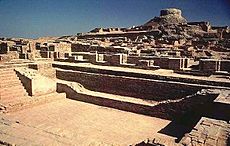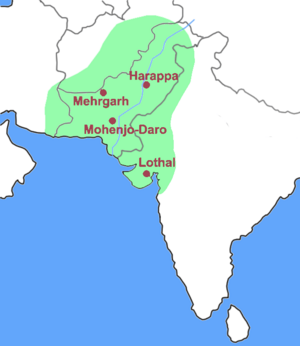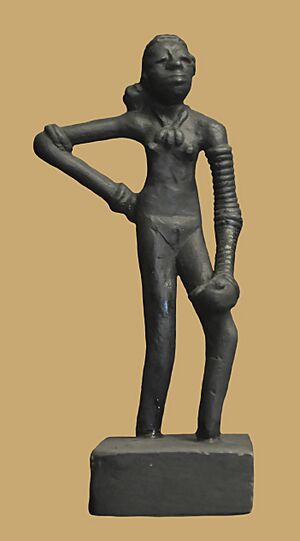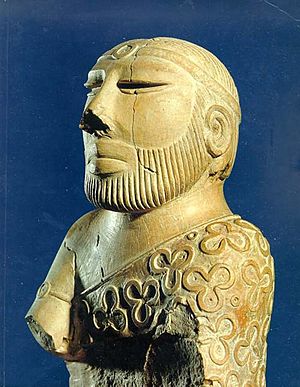Mohenjo-daro facts for kids
Mohenjo-daro was one of the largest ancient cities in the Indus Valley Civilization. This amazing civilization was located in South Asia.
The city was built around 2600 BC (Before Christ). It is found in the province of Sindh, Pakistan. Mohenjo-daro was one of the world's first big cities. It existed at the same time as the ancient civilizations of Egypt, Mesopotamia, and Greece. Today, the ruins of Mohenjo-daro are a UNESCO World Heritage Site. It is a very important part of Pakistan's history.
Contents
A Look Back in Time
Mohenjo-daro was built in the 26th century BC. It grew to be one of the biggest cities of the ancient Indus Valley Civilization. This civilization started around 3000 BC from an older culture.
At its strongest, the Indus Civilization covered a huge area. This included much of what is now Pakistan and North India. It stretched west to the Iranian border and south to Gujarat in India. It also went north to a place called Bactria. Other important cities of this time were Harappa, Lothal, Kalibangan, Dholavira, and Rakhigarhi.
Mohenjo-daro was a very advanced city for its time. It had amazing civil engineering and city planning. For example, it had good drainage systems. Around 1900 BC, the Indus Civilization suddenly started to decline. Because of this, Mohenjo-daro was left empty.
Amazing Discoveries
Many interesting things have been found at Mohenjo-daro. These items help us learn about the people who lived there.
The Dancing Girl
One famous discovery is the "Dancing Girl" statue. This artifact is about 4,500 years old. It is a small bronze statue, about 10.8 centimeters (4 inches) tall. It was found in 1926 inside a house in Mohenjo-daro.
A British archaeologist named Mortimer Wheeler really liked this statue. He described her in 1973:
- "She has pouting lips and an insolent look in her eyes. She's about fifteen years old, I think. She stands there with bangles all the way up her arm and nothing else on. She looks perfectly confident of herself and the world. There's nothing else like her in the world."
John Marshall, another archaeologist, also described her. He said she looked like a young girl with her hand on her hip. Her legs were slightly forward, as if she was dancing to music.
The Priest King
Another important find is a seated male sculpture. It is often called the "Priest King." However, there is no proof that priests or kings actually ruled the city.
Archaeologists found this sculpture in 1927. It was in a special house with fancy brickwork. The sculpture was lying between brick walls that once held up a floor.
This sculpture shows a man with a beard. He wears a headband and an armband. His cloak has a special pattern with three leaves, which was once filled with red color.
Images for kids
-
Map showing the major sites and theorised extent of the Indus Valley civilisation, including the location of the Mohenjo-daro site
-
The straight streets and buildings show that Mohenjo-daro had careful urban planning.
-
View of the site's Great Bath, showing the surrounding urban layout
-
Digging at the city showed very tall wells (left). It seems they were built higher as floods and new buildings raised the street level.
-
Boat with direction-finding birds to find land. This is a model of a Mohenjo-daro tablet from 2500–1750 BCE. It is kept at the National Museum, New Delhi.
See also
 In Spanish: Mohenjo-Daro para niños
In Spanish: Mohenjo-Daro para niños















